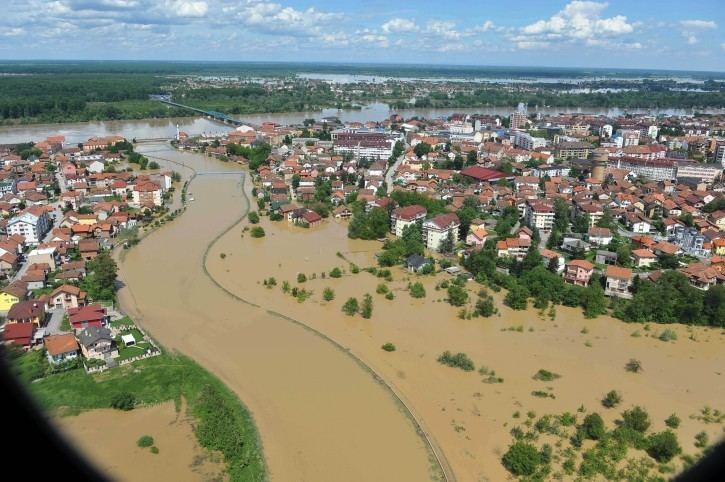Country Serbia Settlements 23 Postal code 15314 Local time Saturday 1:49 PM | Time zone CET (UTC+1) Area 342 km² | |
 | ||
Region Šumadija and Western Serbia Weather 21°C, Wind W at 14 km/h, 28% Humidity | ||
Volunteering in krupanj serbia one of the hardest hit areas
Krupanj (Serbian Cyrillic: Крупањ, [krûːpaɲ]) is a town and municipality located in the Mačva District of the western Serbia. The municipality has a total population of 17,295 inhabitants, while the town has a population of 4,429 inhabitants (2011 census).
Contents
- Volunteering in krupanj serbia one of the hardest hit areas
- Map of Krupanj Serbia
- Geography
- Settlements
- History
- Demographics
- Ethnic groups
- Tourism
- References
Map of Krupanj, Serbia
Geography
The town lies in western Serbia, at the southern border of the Pannonian plain and Mačva region. It is surrounded by the mountains Jagodnja, Boranja and Sokolska planina, in a picturesque valley intersected by numerous rivers and creeks. In the town itself, the rivers Bogoštica, Čađavica and Kržava conjoin into Likodra, which later empties into Jadar. The town lies at the altitude of 280 m.
The municipality area covers around 242 km2 (93.44 sq mi), and it encompasses 23 villages. It is the center of the region Rađevina, which was named after Rađ, a great knight of Prince Lazar, who defended it from Hungarian and Ottoman conquerors, and who is buried at the monument of Rađev Kamen.
Settlements
Aside from the town of Krupanj, the municipality includes the following settlements:
History
The name 'Krupanj' was first recorded in Ragusan records in 1417. In the Middle Ages, it was a significant silver mining site, frequented by Ragusan merchant caravans. In 1459, it fell under Ottoman rule with the rest of the Serbian Despotate.
The Church of Dobri Potok (Dobropotočka crkva) at the town outskirts, which is devoted to the Holy Ascension of God-bearer Mary, was first recorded in 1528 in Turkish records, making it the oldest preserved church in the Podrinje area. Built in a traditional style, it hosts numerous records and monuments from Ottoman Rule and the 'Serbian Liberation wars' period. It is surrounded by a small ethno-park with several chapels and museum rooms.
The town was first liberated in the First Serbian Uprising in 1804 by the hajduks company of Đorđe Obradović "Ćurčija". Vojvoda Maksim Krstić and count Krsto Ignjatović were leaders of the defense of Krupanj during the uprising. The first basic school in the town was opened in 1837, and the church of Holy Ascension was built in 1842. The Ottomans ultimately withdrew in 1862, and the nearby fortress called "Soko Grad" was torn down, to be turned into the monastery of St. Nicholas.
At the end of 19th century, a lead-antimony smeltery was founded in the city. During World War I, a battle between Austria-Hungary and Serbian forces was fought at the nearby site of Mačkov kamen, the peak of Jagodnja mountain. A charnel house is built in memory of the event. During World War II, in the village of Bela Crkva, partisan Žikica Jovanović Španac killed two gendarmes on July 7, 1941, which would become the official date of celebration of the people's uprising against occupiers in Serbia during communist rule.
On September 26, 1941, a meeting of partisans' Main Headquarters, presided by Josip Broz Tito, was held in the nearby village of Stolice. A monument and memorial park were built after the war, celebrating the event, but it has been fairly neglected in the recent past. As the town was one of the centers of the Republic of Užice, it was burned to the ground by German occupiers in late 1941, with only a few buildings surviving.
Krupanj was affected by unprecedented flooding in May 2014. Many houses, roads and a bridge were completely destroyed.
Demographics
According to the 2011 census results, the municipality has a population of 17,295 inhabitants.
Ethnic groups
The ethnic composition of the municipality:
Tourism
Krupanj is an underdeveloped municipality, but its clean and undisturbed natural environment, and its richness in historical monuments offers significant touristic potential. Currently, there are two hotels in the town Center. The Church of Good Creek is a rare preserved building of traditional sacral architecture. Numerous historical monuments from the World Wars include the ones at Stolice, Mačkov kamen and Cer mountain. The monastery of Tronoša and the ethno-park in nearby Tršić preserve the memory of Vuk Stefanović Karadžić, a 19th-century reformer of the Serbian language.
At the site of Mačkov kamen there is also a small ski resort. The area is suitable for hiking and biking, and the numerous creeks are rich in fish, especially trout; there is an organized fishing ground at the site of Zmajevac. Numerous sporting grounds (including a sports hall and Olympic-sized open swimming pool) and a pleasant climate offer support for sports tourism, used by numerous sport clubs from Serbia and nearby countries.
